Lilly Bits O' Heaven - Angelic Shichon Puppies

Our Litter Box Training Methods
At LillyBits we litter box train our puppies and have found that it makes the potty training process much easier on their new families.
We begin litter box training at three weeks old and by the time they are eight weeks old they are little pro's. It is very nice because the puppy has always known that there is a place to hold it and a place to go potty. They never have slept, played or ate in their own 'mess'. We have found that this makes the completed potty training process much easier for them and their new homes.
At LillyBits we use a specific method we have developed over the years to raise our puppies. Our potty methods begin at three weeks old and we believe this gives our puppies the best head start possible. We carefully watch each litter to know when to graduate puppies to the next phase. No litter of puppies is EXACTLY the same and we make small adjustments to set up our pups for success.
Phase One
This is the first phase of the litter box training. This begins when the puppies are three weeks old. By four weeks all the puppies are toddling in and out of the litter box. Instinctually dogs do not want to soil their 'den'. The only area that is not their den is their litter box. The puppies naturally begin using the litter box for their bathroom duties.
As you can see this is set up nicely so Momma dog approaches from the side easily. Our Momma's have their own potty place and never soil the area their puppies are being raised.
Phase Two
This is the second phase of litter box training. We use an exercise pen with a crate and potty box.
When we see that our puppies are ready to graduate to phase two this is how our set up looks in the nursery. The space required for this 3 ft by 6 ft but there are many different options for puppy safe playpens.
It works very well and many of our LillyBit families replicate this set up in their own home for a smooth transition. All of the supplies needed to set up this 'puppy safe room' are listed in detail on the Shopping List page.
Does my puppy come potty trained?
I wish I could answer YES! The truth is no, your puppy comes litter box trained, it will still require work from you to complete the potty training process. So we will not go down the primrose path together, instead, we will talk about realistic expectations :) What you get is a nice head start and a good foundation to build on. In your 'puppy safe room' setup, if you have done things correctly, your puppy will use the litter box. I can not stress enough the importance of getting the right equipment to begin with.
Your puppy will not be ready for unsupervised freedom in the house. Your LillyBit will not be like an adult cat that you can show where the litter box is and then they will go find it every time they have to go. You will need to supervise your puppy and when you see signs they have to go potty prompt them to use their litter box. Some signs a puppy has to go potty is turning circles, disappearing behind something and sniffing. If you are holding a puppy and they have to go potty, often they get squirmy. It is good to use a command word when you are prompting your puppy to go potty. I use "good potty" with an affectionate rub. Sometimes your puppy will be so busy they don't want to take the time to go potty and you will need to insist and keep prompting them with 'good potty' and putting them back in the box until they use it. With my little guy Griffin sometimes it would take 10 tries! If they don't go, you can use your crate to put them in and wait 10 minutes and try again.
You can expect your puppy to have to use the bathroom after a nap, playing, eating or drinking. I would wait until you see your little one use the litter box in their 'puppy safe room' and then bring them out for their playtime directly after. In the beginning the key to successful housebreaking is supervise, supervise and more supervision! Really, in the beginning we are the ones that are potty trained!
At night we suggest using a crate for your puppy to sleep in. For the first few nights be prepared to wake up early and let the little one out to relieve themselves in their litter box. After they have relieved themselves it is okay to put them back in the crate and get a little more sleep. In the evening pick up your puppies food and water after 6:00 pm and be sure to give your puppy a chance to eliminate before bed.
The nice thing is that you do have your 'puppy safe room' set up so that you can put your puppy in while they can't be supervised or you are at work and the litter box is available to them. In the beginning I would have the litter box be the only absorbent surface other than their bed or crate. Often when a family has experienced a problem with the litter box and their new LillyBit it has been traced to a litter box that is too small, or tall etc... The litter box needs to be large enough for your puppy to do the potty dance :) We use the PUPPY GO HERE dog litter box found on Amazon and in our store!
Here is a direct quote from an email we got from a LillyBit home in regard to the housebreaking process:
"As of last week Junior has gotten run of the house. No more litter box or puppy corral. He uses the doggy door to go out back and take care of business and when left at home alone we have had no problems. "
The Schneider Family ~ San Diego
Email dated March 17, 2008 ~ Junior was Born on October 21, 2007 so he was just shy of five months old when this email was written.
Phase Three
The third phase of the housebreaking process depends on you. Do you want to continue to use the litter box? Would you like to use a doggy door and transition to outside? We have our adults here at LillyBits trained to do both outside and the litter box. You can use the turf or even the litter box to mark the spot outside you would like your puppy to do their business, just be sure to bring it in each time.
If you have used supervision and consistency with your puppy, phase three should happen almost naturally. We have had many reports back that the head start they are given here at LillyBits really does make housebreaking a much less stressful event. Phase three starts when you have been able to consistently avoid accidents in times of supervised freedom and you notice that your puppy is holding their potty to wait for their elimination spot. Each dog is an individual but normally this happens sometime between 16 weeks - 24 weeks old. See diagram below.
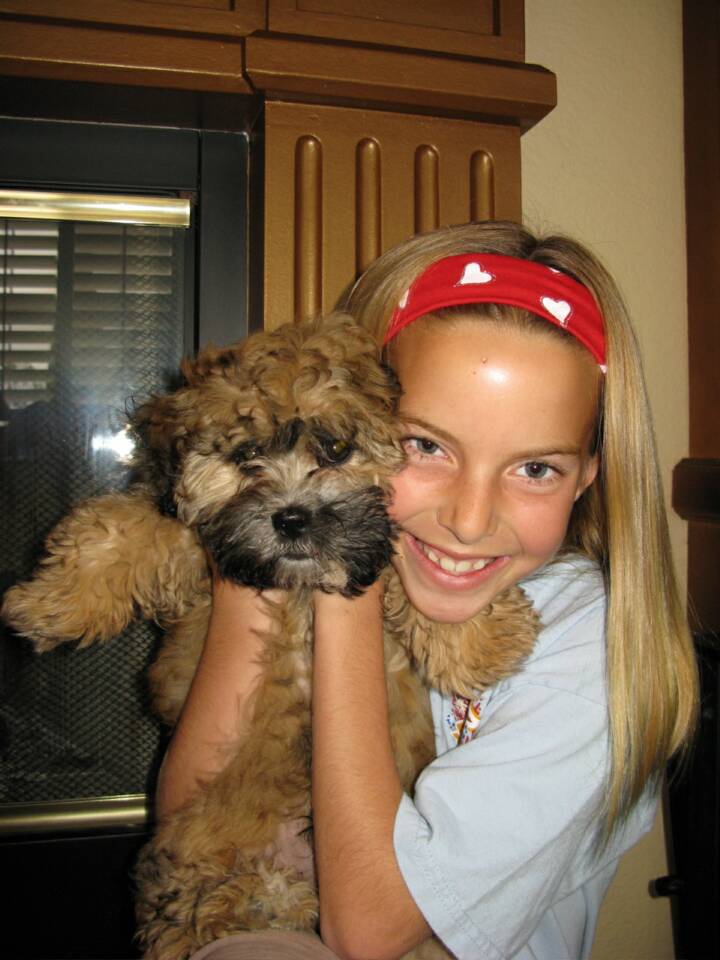
What if I don't want to use a litter box at all?
If you do not want to use a litter box set up in your home you would then go right to crate training. Remember that a puppy can only be in a crate 1 hour for each month of their age plus one. So a 8 week old puppy can only be in a crate for 3 hours at best. Especially if you are at home or you have access to come home for the afternoon potty break - moving to crate training right away is in an option but maybe frustrating with such a young small breed puppy. We think that continuing what we have started here until the puppy is at least 12 weeks is important. Eight week old puppies just don't have the bladder maturity to hold it until you can get them outside. At about 12 weeks of age they make great strides in this area.
Here is an article on Crate Training:
Also a wonderful article on Potty Training:
Junior Schneider
Phase Three Diagram
They say a photo is worth a thousand words, so here is a photo diagram of my home office when I am bring one of our own dogs through phase three potty training. Of course you would eliminate the potty portion of this diagram and take your puppy outside to eliminate. Our dogs are all cross trained. I wrote a more detailed blog post on this if you would like to read it. This puppy had been transitioned from pellets to the Spotty Dog Training Place.
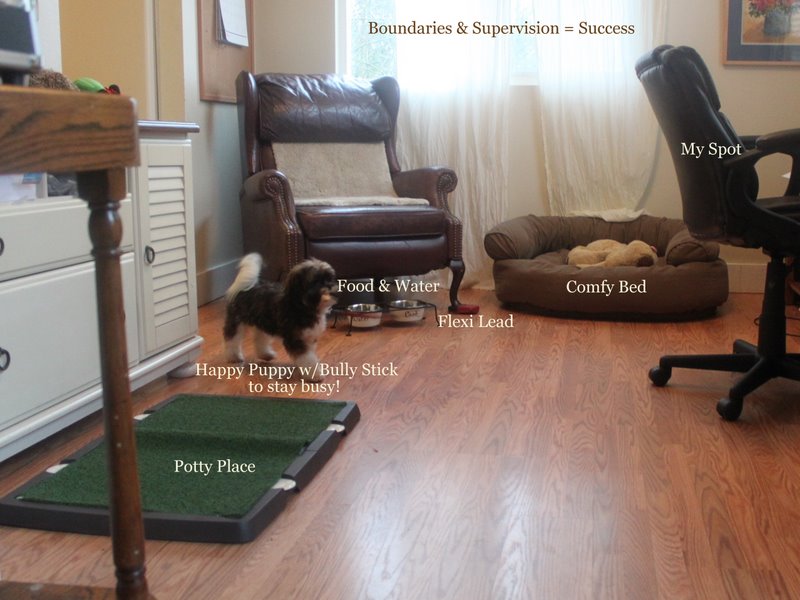
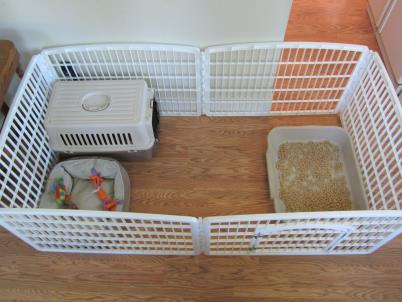
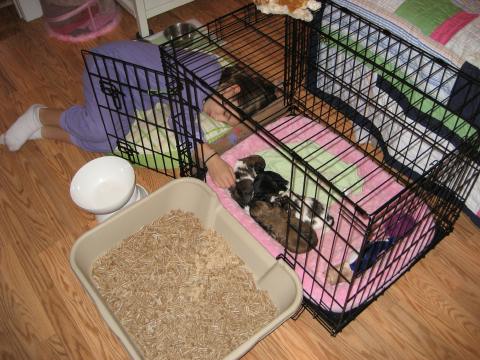
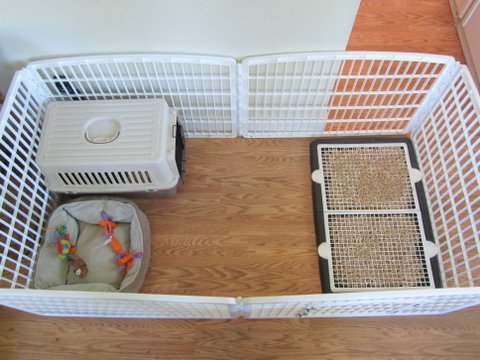
Example of set up using a Spotty Dog base to transition from pellets to turf system. Note: We can not provide after support for this transition but thought a picture is worth a thousand words.